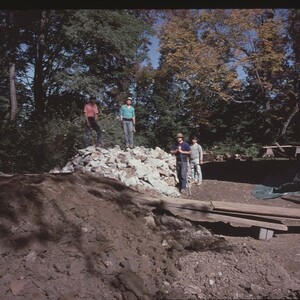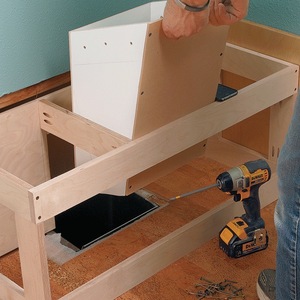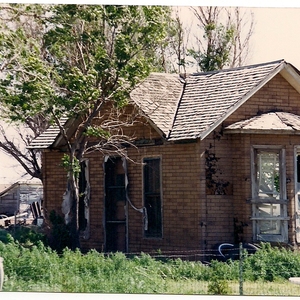Remembering an old article in FHB dealing with the connection of the ground line to the groundrod.
Seems I remember the recommendation from someone in the article to buy some special blasting cap mechanism which when placed on the connection and ignited it would braze the line to the rod tight and secure a solid connection.
Got me to thinking why just soldering the line to the brass connector and ground rod wouldn’t suffice just as well.
What are the major methods of securing the line to the brass connection and ground rod besides just bolting it tight?


















Replies
The opposition to only soldering the grounding wire (without the clamp) is that lightning can push enough current through the wire to melt the solder, thus eliminating the connection to the rod.
Your idea is to use both clamp and solder. I see only two possible negative things about your idea. The first is that I think it might be hard to get the solder to "take" to the ground rod. The other is that if the solder did melt, then you'd no longer have that extra-low-resistance connection provided by the solder. I don't know how likely it is that the solder would get melted, but it doesn't seem very likely to me.
I have welding torches, so on my house I clamped the wire and then brazed the clamp to the rod. You might try using a MAP gas torch to braze them.
The exothermic welding device you mentioned would be faster and easier, but will cost you around $10 per rod. "One Shot" by CadWeld is one brand of that device.
To connect your ground wire to your ground rod, the grounding wire should be bare, solid ( not braided) copper, usually No. 4 guage or thicker, and should be connected to the copper rod via use of an acorn nut clamp.
If you torque it down hard enough, the clamp should not work loose....If you are worried about that prospect, then use several clamps...they won't all come loose.
BTW, you should have at least two 8ft long copper rods in the ground, at least 6 ft apart for your grounding purposes. You can have more rods, this is minimum. That bare grounding wire should be unbroken and connects to both rods. The acorn clamp is the approved method of attachment, so I would go that route if I were you.
End of story.
Davo
You should use an approved method. Even though soldering sounds good, it's not permitted because of the reasons stated above.
Exothermic welding is a premium method, but rarely done in residential construction. The method which most people use, and a perfectly fine one, is to use ground rod clamps. They have to be electrical ground rod clamps -- any kind of hose clamp or other makeshift clamp is not permitted.
The ground wire may be either solid or stranded. In fact, you can't get solid wire large enough, so stranded is what is used. Braided wire is used for electronics, and doesn't exist in large sizes.
A sidelight to soldering. Ran a test once with a 2 AWG inside a 1/2 ferrule bolted into a clamp. The ferrule was crimped and soldered. 150kA would melt the solder, and the lubrication provided by the molten solder was sufficient to let the wire be pulled by magnetic forces out of the crimp.
Which brings up another facet of hooking up ground rods, esp for lightning. Currents going in the same direction pull together the wires, in the opposite direction they push the wires apart. So, DO NOT loop your ground wire down alongside the ground rod and then back up into a clamp, put it into the clamp straight from the top. The down the side method puts currents in opposite directions and I've literally broken 500 MCM cable in tests at >500 kA (yes, 1/2 million amps) when there was a loop in the cable.
Ok. So I'll run the ground wire to the top of the ground rod and down into the clamp and probably should double clamp it.
Are two ground rods recommended?
Are two ground rods recommended?
Yes. Code says that you can use one rod if it tests at 25 ohms or less to ground. If not, you are required to put in another rod at least 6 ft. from the first.
Testing requires a special device, not just an ohm meter, so I've never bothered to do it. It might be worthwhile for the guys who do lots of service work, but not for us little guys.
If you do two rods in the first place, the inspector signs off, badda boom, you're done.
-- J.S.
Well I'm not concern about an inspector since I live in the underground but just want to do the best I can within reason.
Two it is. Thanks.
It is just me, or was that an unusually info-packed thread? Former test engineers playing with huge currents, electricians with industrial experience, etc throwing in their 2 cents to answer the question at hand and give good rationales and background. Good jobs, guys!David Thomas Overlooking Cook Inlet in Kenai, Alaska
The clamping of wire is a very good connection, but the contact from the rod to the dirt is usually bad. There is so much resistance to the ground. A better ground rod would be the bottom rebar in your footing.
To test my theory, run a #12 wire from a hot 20 amp breaker to the rod. Make sure there is no other wire on the rod. If the rod is grounded really well, it should trip the breaker. It will probably not trip, even with a 15 amp breaker.
I agree. Isn't the earth-groundrod resistance on the order of a few ohms? In that case, why bother reducing the groundwire to groundrod resistance from 0.01 to 0.001 ohms. If anyone is that concerned, it is probably best to connect the groundwire with a pair of acorn nutz on each groundrod to ensure at least one is functioning.
Yes, the impedance of the rod to true earth is usually high enough that you could drive electrons straight into the dirt and not trip even a 15 amp breaker. But the concern here is with the unusual and extreme conditions of a lightning strike. I don't know whether the impedance of the ground rod would be constant in that case, and even a small fraction of an ohm can do strange things when you get into tens of k-Amps.
There are some places, recording studios and TV transmitters, where they bother to sink rods 40 - 60 feet down, and get down to tenths of an ohm. A friend of mine used to do those installations years ago, back when UHF was starting up.
-- J.S.
I had a county inspector write me up because I installed two rods. I added a second so I could ground the HVAC outside unit to it. He did not like that. So I drove it completely under and covered the copper with dirt and it pass, but he was looking real hard behind the HVAC unit.
Around here the only requirement for inspector is to be somebody brother in law
The best employee you can have but you wouldn't want him as a neighbor " He the shifty type"
Most people have never heard of "exothermic welding" but just as a point of information it IS the ultimate method for connecting grounding electrodes and grounding electrode conductors.It's also the standard for bonding the structural steel in a commercial or industrial building to the building's electrical system.A lot of electrical engineers spec it on drawings for customers who want a "Cadillac" job.The company I work for does a fair amount of work for the Postal Service and they always require it for their electrical services.
In Cadwelding you have hinged graphite molds that are about 4" square by 8" high.There are separate molds for welding different size or number of wires to ground rods,columns,other wires,etc.There are "T" molds for joining together pieces of the grounding grid.You open the mold,insert your conductor and rod together,and clamp it shut.There's a chamber on top that you put a special copper/aluminum alloy "penny" into, and then on top of that pour the weld material (which looks like powdered graphite or gunpowder).The weld material "shot" comes in a container like a film canister and at the bottom of it,which is poured last, is a special starting powder which you pour to the very edge of the mold,and close the top door.They usually come with a flint igniter.When it lights off the weld material gets so hot that the "penny" melts along with the surface material of the grounding elements to make almost a solid copper "T" or "X".You open the mold and scrub it clean with a wire brush.The resulting connection has the same ampacity as the conductor, which is far superior to a clamped connection even before ground moisture starts to work on it.
A couple of things to never do :
# 1. Leave the top open to see what it looks inside when it fires.I used a welding hood to do this once and I'm pretty sure that's what the surface of the sun looks like.
# 2. Shoot a cadweld with a mold that is damp.We had an apprentice drop a mold in a puddle and thought that drying it off with rags would be enough.When he went to use it the moisture in the graphite superheated and the mold exploded.When the molds are on the job we try to keep them right next to the heater in the trailer.
# 3. Cadweld a ground wire to a water well casing that has natural gas in the well.This happened to an electrician I know,who had to grow a new beard and eyebrows.I'm told that the gas company puts that nasty smell in natural gas so you'll know when it leaks,but "natural" gas is harder to detect.
"I'm told that the gas company puts that nasty smell in natural gas so you'll know when it leaks,but "natural" gas is harder to detect."
Yes, the gas company puts in mercaptans which are stinky sulphur-containing compounds so that people can notice leaks. Some natural gas used in industry is "de-odorized" because the sulphur interferes with some catylsts they use.
And yes, natural, natural gas (like from a landfill, swamp, old outhouse, etc) does not have those mercaptans in it. I've had about about a dozen sites producing methane and none could be smelled, other than a faint, anaerobic-degradation kind of smell that I've come to recognize. A little like the mud flats at low tide. Only a few that reached explosive levels, but exothermic welding would be a bad idea there, for sure.David Thomas Overlooking Cook Inlet in Kenai, Alaska
I've actually been in the room where the gas company adds the mercatans to the natural gas. Talk about stinky!!!! The facility I was at had it stored in a big 400 or so gallon tank and it was metered out at something like drops per 100K cu ft. Really, really potent stuff.
Rob Kress
a faint, anaerobic-degradation kind of smell ...
recognize it! I can't even pronounce it!You get out of life what you put into it......minus taxes.
Marv
How much does the kit cost to do one of these ?
carpenter in transition
As to the price you'd have to do a Google search for Cadweld and check out the distributors.I just install 'em and rarely have a clue what anything costs.
I suspect what the inspector did not like was you grounding the HVAC unit to one grounding rod, and the rest of the electrical system to another. It's not allowed. The two ground rods need to be connected to the one, single, unspliced ground wire which connects to the electrical system at the main panel.
Back to the original poster, the connection between the ground rod and the earth is important for the system to function properly. This is especially true when the system is responding to an electrical spike. Surge supressors need something really easy to send the surge to, and a weak connection to ground compromises their ability to protect. If you live in a typical temperate climate where the soil is always moist, you should have no trouble. If you live in the southwest, or live in really sandy soil that dries quite thoroughly in the summer, you may have to take additional measures to obtain an adequate ground.
Although the resistance between grounding rod and earth may be several ohms, it isn't at all hard to imagine the resistance between the acorn nut and the rod also being several ohms after years of exposure to the elements. Brazing or welding the wire to the rod eliminates that possibility.
Using a 5/8" rod rather than a 1/2" rod gives you 25% more surface area contacting the earth, which reduces resistance a little.
Someone mentioned using the rebar in a footing for a ground. I've read that a lightning strike can heat the rebar to the point of boiling the surrounding moisture and causing the footer to crack. Seems a little far fetched, but then I've personally seen a tree split because lightning boiled the sap in the tree.
Somewhat off-topic, but perhaps of interest... Exothermic welds are also used to join rails when constructing railroad tracks (creating "continuous rails"). Chemistry is cool...
"Somewhat off-topic, but perhaps of interest... Exothermic welds are also used to join rails when constructing railroad tracks (creating "continuous rails"). "
Even more off-topic, but in these new continous-rail railroads, how does the metal expand on a hot day? Wouldn't it bow all over? I've wondered but not researched it.David Thomas Overlooking Cook Inlet in Kenai, Alaska
About those continuous rail railroads:
I think that they are used on curves. That way, when they expand, the direction of the curve is already set.
~Peter
Rails are installed at elevated temp, so operate under tension & resultant deflection, side movement limited by ties, etc. Expansion due to temp reduces tensile deflection.
Tshinconsin, TGV, etc that have concrete sleepers (or straight concrete roadbed with rubber dampers) can also restrain the rail for a limited amount of compression.
There are temperature rules in place on most lines that if the temperature aprocahes/exceeds the design limits, reduced speed limits are imposed. There have been derailments due to high temp kinks in the rails.
Pop and Grandpa were old railroad people from Wabash, etc. days, and there apparently was quite a discussion when welded rails started to be installed, recall Pop saying in the 50's when welded rail was first being used that there would still have to be expansion joints every 1/2 mile or so, but believe there are none at all now, the tensile capabilities of the weld sufficient to handle the tension created in cold weather.
Edit PS, really off the subject - anybody taken the Chunnel train?
Edited 12/30/2003 10:53:48 PM ET by JUNKHOUND
at that time , the outside hvac wasn't setting on the pad, nothing there. and the two rods was connected together about eight feet apart. The purpose of the HVAC rod was we have alot of lightin strike so it was extra protection for the outside hvac unit.
The best employee you can have but you wouldn't want him as a neighbor " He the shifty type"
There's a code spec around here for how much resistance is acceptable between the rod and the earth. I don't know exactly what it is (not my specialty and I don't have the equipment to test that anyway), but a L.E. would know. Ground types vary widely; some places one ten-foot rod does the trick; two miles down the road it doesn't and a 10x20 copper grid has to be buried 6 feet down....
On this one, I think it best to let the L.E. nail it down, especially in an area where lightning strikes are a major concern.
Dinosaur
'Y-a-tu de la justice dans ce maudit monde?
http://www.thermoweld.com is the "welded" style ground rod you seek.
Someone else said this is generally not the method used in residential construction. It would be the first one I heard about as well. These are generally reserved for industrials with high profile issues. i.e. Floating grounds in large expansive concrete manufacturing plants where the ground rod has a hard time reaching a moist enough section of the earth to drain off the neutral current, or high profile generator sets that keep places like Intel running without power interruption. It is really not for the home.
As for soldering...I have vast experience working as a work standards engineer in a GM assembly plant that makes printed circuit boards. There are 800+ ways to screw up a solder joint. Crystalized solder happens from contaminated solder, uneven heating and / or physical stress. Crystal size in solder determines the conductivity. Dull, crazed,or uneven color are just a few of the symptoms of a bad solder joint. Even in your own house you could be looking at liability down the road when the ground disappears from your system with a failed solder joint. Don't do it, just talk about it for fun.
Use acorn nuts. These are made by panduit, T&B, ... these are UL approved and despite the issue of wether they will stay tight, don't worry, the code covers that. (you are supposed to use 2 rods 6 foot apart on an unspliced wire.) that means 2 acorn nuts. Whatever the odds are that one will "go loose" they just got diminished by an astronomical amount by having 2 in a series. Besides. electricity pulls these parts together in the lightening strike. If you torque the acorn nuts like on the label, all will be fine.